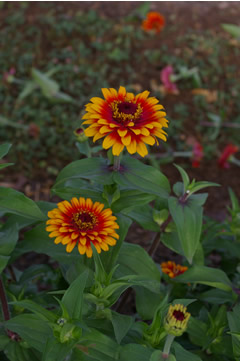Zinnia ‘Zowie Yellow Flame’
go.ncsu.edu/readext?229467
en Español / em Português
El inglés es el idioma de control de esta página. En la medida en que haya algún conflicto entre la traducción al inglés y la traducción, el inglés prevalece.
Al hacer clic en el enlace de traducción se activa un servicio de traducción gratuito para convertir la página al español. Al igual que con cualquier traducción por Internet, la conversión no es sensible al contexto y puede que no traduzca el texto en su significado original. NC State Extension no garantiza la exactitud del texto traducido. Por favor, tenga en cuenta que algunas aplicaciones y/o servicios pueden no funcionar como se espera cuando se traducen.
Português
Inglês é o idioma de controle desta página. Na medida que haja algum conflito entre o texto original em Inglês e a tradução, o Inglês prevalece.
Ao clicar no link de tradução, um serviço gratuito de tradução será ativado para converter a página para o Português. Como em qualquer tradução pela internet, a conversão não é sensivel ao contexto e pode não ocorrer a tradução para o significado orginal. O serviço de Extensão da Carolina do Norte (NC State Extension) não garante a exatidão do texto traduzido. Por favor, observe que algumas funções ou serviços podem não funcionar como esperado após a tradução.
English
English is the controlling language of this page. To the extent there is any conflict between the English text and the translation, English controls.
Clicking on the translation link activates a free translation service to convert the page to Spanish. As with any Internet translation, the conversion is not context-sensitive and may not translate the text to its original meaning. NC State Extension does not guarantee the accuracy of the translated text. Please note that some applications and/or services may not function as expected when translated.
Collapse ▲Trial Started: 2005
Year of Trial: First (from 2005 report)
Good Qualities
Exciting unique bicolor/ tricolor (10); Flowers were consistent in doubleness and bicolor ring size; Everyone loves them. Lots and lots of branching; When we had these bunched alone, they were often the first bunches to be bought at market, so they did catch people’s eye; Many, mostly it was the sunshine nature that endeared it to the customers, usually the center yellow was ringed in a shade of violet/pink, then subsequent rings of red, yellow, and orange or blendings of them – flowers were about 2 inches across and could stand alone or look fabulous paired with red or carmine globes, neon dianthus, red, orange and yellow zinnias (esp the less popular singles) or deep red dianthus; Farmer’s market customers loved it – loved the color; Hardy stems, long lasting; It worked especially well with fall bouquets; Youthful appeal; Stands out in bouquets, prolific bloomer; Good flower size; My customers really liked this one a lot.
Problems
Short stems (7); Had to use as sprays or bouquets; Was planted in a dustier area of the field and did suffer from mite infestations; Not problems, did not repeat bloom as quickly as other zinnias, but we were still cutting them heavily to keep up with demand, some did not have the violet ring but most times the customers did not care, some bug pressures as other zinnias, some powdery mildew toward end; Some bugs; Flowers not very double, flower petals narrow, ie. gappy; 1st to start getting leaf spot.
Postharvest
I found that this zinnia needs to have a good stage of maturity before it is cut, too early of a cut inevitably led to a blending or loss due to age, waiting too long, however meant center would brown, timing was important, but these sold so quickly that once I discovered its habits, I could make adjustments without much bending or loss due to age – we used Floralife, gave customers some and told them to change out water at every day or so; Floralife. See separate postharvest report in this issue for results from NC State University postharvest evaluations.
Trial Data
| Yield (stems/plant) | Stem Length (inches) | Market Appreciation Rating¹ | Repeat Again Rating¹ | Ease of Cultivation Rating¹ | Average Spacing (in2) | Average Postharvest Life (days) | |||
|---|---|---|---|---|---|---|---|---|---|
| Wholesale | Retail | Consumer | |||||||
| Average | 7.6 | 14.0 | 4.0 | 4.0 | 4.7 | 4.5 | 4.4 | 112 | 9.3 |
| Range of Responses | 1-22 | 6-20 | 3-5 | 3-5 | 4-5 | 3-5 | 3-5 | 12-288 | 7-12 |
¹1 to 5 scale, with 5 being the best. Market ratings are based on sales to wholesalers, retailers, or final consumers direct.
Supplier
Goldsmith Seeds
P.O. Box 1349
Gilroy CA 95021




Comments
Had 5 plants left after Hurricane (Dennis) and they were still producing numerous branching and flowers until Hurricane Katrina; Seeded in a 128 cell flat on 4/24/05, transplanted 91 plants to field, harvest interval was 7/28-8/22; We liked this one; The most loved flower in my whole garden this season, it came to be called the “Sunshine Zinnia” and was asked for by that name; Very similar in coloration to gaillardias, but way more useful and sturdy!; THE hands-up favorite of my customers this season – I will grow LOTS more next season! – Always the first to sell out, customers bought for themselves and everyone they knew – The “Sunshine Zinnia”!!; The stems were too short for most of the summer, but began to be a satisfactory length in October; I got the best results I have ever gotten from a bicolor zinnia with this cultivar; 1st harvest in late June, florist loved them for 4th of July then interest waned; Too short most of season, like them again now – mid-October.